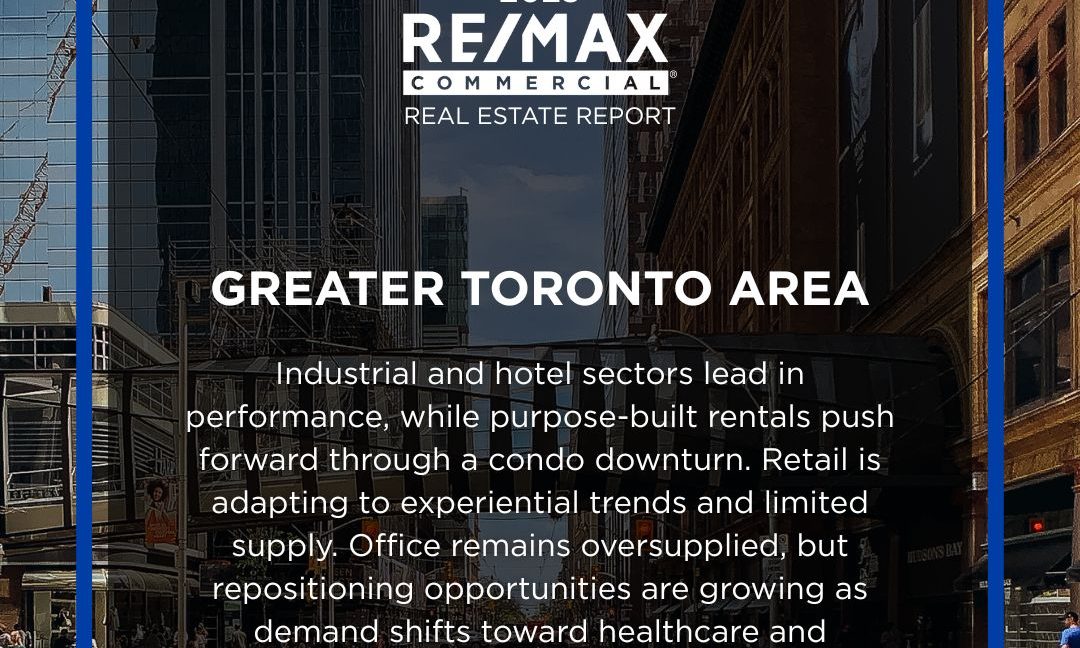Looming trade wars continue to weigh on investment in the Greater Toronto commercial real estate market, with leasing and sales activity slowing year over year across nearly all asset classes. While formal trade talks between the U.S. and Canada have yet to begin, and a resolution remains distant, the uncertainty in the market is creating opportunities for near-and long-term positioning of assets.
Industrial corridors expand to outlying areas
Industrial continues to be the top-performing sector in the GTA. Availability rates in Q1 2025 stood at 4.6 per cent, the second lowest in the country, but 40 basis points above last year during the same period, according to Altus Group.
Although demand is still present, absorption rates have eased from peak levels, creating more balanced market conditions and prompting landlords in the city proper to offer increased incentives. Industrial corridors developing along the 400-series highways in areas including Whitby, Ajax, Pickering, Kleinburg, Bolton, Caledon, Nobleton, and Georgetown, are drawing a growing number of buyers and tenants as larger, modern buildings offer even more competitive lease rates. In bedroom communities such as Markham, Vaughan and Scarborough, adaptive reuse of existing industrial spaces continues, with a growing trend toward recreational conversion for uses like pickleball, padel and golf simulators.
Hotel sector outperforms across the board
Current dynamics in travel and tourism are stimulating further growth in domestic and international travel, given the current pull back to U.S. destinations. Altus Group recently reported the hotel sector was the top performing asset class in commercial real estate in 2024, with a 48 per cent increase in growth in 2024, compared to the previous year. The Greater Toronto Area, in particular, experienced significant gains, with $552 million in dollar volume transacted, an increase of 173 per cent over 2023 levels. The upswing reinforces Toronto’s status as a top destination for leisure and business travel and a major hub for investors to diversify their portfolios.
Purpose-built rental pushes through condo downturn
The multi-family asset class continues to navigate upheaval in the Greater Toronto Area. While the collapse of the condominium market has had a substantial impact on the sector, construction continues on purpose-built rentals. More than 700 rental units began construction in the first quarter of 2025 in the Greater Toronto and Hamilton Area (GTHA), predominated within the 416 area code, as activity in the 905 area code declined, according to a recent report by Urbanation. Vacancy rates in the city rose by over 90 basis points year over year to 3.5 per cent. Yet, Urban Toronto reported a record-setting number of residential proposals submitted in Q1, representing close to 26,000 new rental units—more than double the 9,931 proposed during the same period in 2024. Financing, however, remains a challenge despite the various funding programs available from the Canada Mortgage and Housing Corporation (CMHC). Applications are now closed to the popular Housing Accelerator Fund, which was designed to “remove barriers to build more homes, faster.”
Retail adapts and holds firm
Retail, by contrast, remains relatively stable despite notable disruptions. The bankruptcy of the Hudson’s Bay Company marked the end of an era, but lease rates have held firm in large part due to low vacancy rates and evolving mall strategies. Shopping centres across the GTA continue to expand their offerings, incorporating residential units, restaurants, entertainment venues, and niche grocery stores. Malls in the 416 and 905 area codes, led by Yorkdale Shopping Centre, Square One and the Eaton Centre, continue to lead in national performance rankings, according to ICSC 2024 Performance Rankings. Yorkdale remains a standout with lease rates now over $2,300 per square foot—$800 more than any other Canadian mall. The void left by HBC’s exit is expected to be absorbed by new retail ventures. Retail plazas remain a top target for investors, especially those with mixed-use development plans. Ideal properties are anchored by grocery or banks, but inventory in the Greater Toronto Area is scarce and new developments are hindered by limited shovel-ready land and planning constraints.
Office sector wrestles with oversupply
Overall office vacancy in the downtown core remains elevated, hovering at 18.8 per cent in the first quarter of the year according to Altus Group, although top-tier A+ buildings are experiencing much stronger occupancy rates. Many large organizations are scaling back their footprint, while merger activity grows as firms seek to lower risk and operational exposure. B-class space remains relatively steady while C-class office space focused on medical use is performing well. Chronic shortages in healthcare facilities, seniors’ residences, student housing, tech space and medical and biosciences labs make a solid argument in favour of repositioning of aging B and C-class inventory. The aging population in the GTA further underscores the need for more purpose-built rentals and healthcare-oriented developments.
Investment sentiment remains cautious. Institutional investors and REITs are hesitant but smaller players may be drawn back into the market by the federal government’s proposal to re-introduce the multi-unit residential building (MURB) cost allowance. This would allow investors to claim depreciation and expenses against unrelated income—a model that previously helped create approximately 200,000 units between 1974 and 1981.
To restore momentum in construction and development, further stimulus is essential. The freeze on development charges at current rates in Toronto is simply not enough. The city should look to markets like the City of Vaughan for leadership, which recently cut development charges by almost 50 per cent on low-rise residential to help drive growth in new construction. Additionally, municipal grants and loans for façade improvements could rejuvenate aging office properties, especially those along major transportation corridors and in the downtown core. While current market hesitance is likely temporary, meaningful policy support and a resolution to cross-border trade tensions will be key to restoring confidence in the Greater Toronto commercial real estate market.
The post Greater Toronto Commercial Real Estate Overview (2025) appeared first on RE/MAX Canada.



